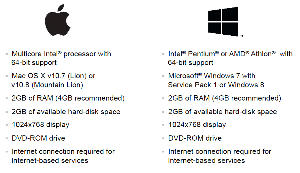One Most Essential Tool for Photographers
When Lightroom first hit the market, there wasn't a lot to differentiate it from other offerings that were available at the time. Since then, it has become an important part of any professional or serious amateur photographer's tool kit. With version 5, it has become indispensable. Version 5 was released last week and, after using a public beta for a few weeks, I was able to start working with the final gold code on Friday before it was released. If you're a photographer, you will want this!
 The only potential problem is whether Lightroom 5 will work on your computer. Whether you use a PC or a Mac, you'll need a 64-bit processor. Windows users need at least Windows 7 with service pack 1 and Mac users need at least Lion (OS X 10.7). Adobe describes the requirements as shown at the right.
The only potential problem is whether Lightroom 5 will work on your computer. Whether you use a PC or a Mac, you'll need a 64-bit processor. Windows users need at least Windows 7 with service pack 1 and Mac users need at least Lion (OS X 10.7). Adobe describes the requirements as shown at the right.
The requirements are substantial for both platforms, but then this is an uncommonly powerful application.
Lightroom Continues as a Standalone Product
 Unlike the components of Creative Cloud, Lightroom will continue to be available as a standalone application with a perpetual license, meaning that once you buy the software, you'll be able to continue using it indefinitely. A new license costs $150, upgrades from any previous version (all the way back to version 1) are $80, and Lightroom is automatically included with Creative Cloud.
Unlike the components of Creative Cloud, Lightroom will continue to be available as a standalone application with a perpetual license, meaning that once you buy the software, you'll be able to continue using it indefinitely. A new license costs $150, upgrades from any previous version (all the way back to version 1) are $80, and Lightroom is automatically included with Creative Cloud.
Most existing plug-ins that worked with Lightroom 4 will continue to work with Lightroom 5. Many of the plug-in manufacturers, though, are scrambling to create versions that will work without an Adobe product. That's because of the marketing change Adobe is making for the upcoming version of Creative Cloud. All Adobe products except Lightroom will be available only by subscription. Alien Skin, for example says that they plan to "stick with the traditional software model. For example, that means that you buy Snap Art 3 and you own it forever," to quote Alien Skin founder Jeff Butterworth.
 The new Alien Skin Exposure 5 in standalone mode. (I'll have a review in a week or two.)
The new Alien Skin Exposure 5 in standalone mode. (I'll have a review in a week or two.)
Butterworth says that Exposure 5, which was also released this week, is Alien Skin's first product that can run as a stand-alone application. Users will be able to run it inside Photoshop, Lightroom, or Aperture—or by itself. Butterworth says that's the plan for all of the company's products.
A Quick Look at Some New Lightroom Features
The new version of Lightroom includes several new major features and 50 or more improvements that Adobe categorizes as "just do it" changes. What this means is that Adobe receives a request from the user community or one of the developers recognizes the need for a small improvement. If it's something that can be added quickly and easily, the developer "just does it".
For example, Lightroom has never supported PNG files. That was probably an oversight but it had never been remedied until now. Lightroom now does support PNG files.
For this first-look review, I thought selecting 3 of the primary big-deal improvements would be appropriate. These are radial filters, Upright, and the improved Spot Removal tool.
 BEFORE: I found this plant at Inniswood Metro Gardens, one of my favorite places to relax with a camera. Because it's a raw image, it's a bit soft. There's also not much to differentiate between the center of the plant and the leaves. This is a perfect candidate for Lightroom's new radial filter.
BEFORE: I found this plant at Inniswood Metro Gardens, one of my favorite places to relax with a camera. Because it's a raw image, it's a bit soft. There's also not much to differentiate between the center of the plant and the leaves. This is a perfect candidate for Lightroom's new radial filter.
Click any of the smaller images for a full-size view. Press Esc to dismiss the large image.
 AFTER: I used 2 radial filters to modify the image, both more or less centered on the flower. One acted on everything outside the flower and reduced exposure by about 1 stop, dropped the clarity, and decreased color saturation. The other acted on a slightly smaller area of the flower to increase sharpness. Then I cropped the photo slightly to place the flower in the lower left part of the frame. The result is a more dramatic image that's more like what I saw.
AFTER: I used 2 radial filters to modify the image, both more or less centered on the flower. One acted on everything outside the flower and reduced exposure by about 1 stop, dropped the clarity, and decreased color saturation. The other acted on a slightly smaller area of the flower to increase sharpness. Then I cropped the photo slightly to place the flower in the lower left part of the frame. The result is a more dramatic image that's more like what I saw.
 BEFORE: This is a hand-held shot and I didn't have the camera exactly level. Everything is leaning just a bit to the left. The skylight doesn't have much detail because it's so bright and the foreground is too dark. This is a job for Lightroom's Upright and a graduated filter or two.
BEFORE: This is a hand-held shot and I didn't have the camera exactly level. Everything is leaning just a bit to the left. The skylight doesn't have much detail because it's so bright and the foreground is too dark. This is a job for Lightroom's Upright and a graduated filter or two.
 AFTER: The amazing new Upright tool took care of the leaning problem. Then, because the view is so monochromatic, I boosted the overall color saturation. The final steps involved adding a graduated filter at the top to darken the overly bright skylight, another graduated filter at the bottom to slightly lighten the dark carpeting, and two more graduated filters at the top left and top right to reduce the effect of the first filter's darkening on areas inside the hallway.
AFTER: The amazing new Upright tool took care of the leaning problem. Then, because the view is so monochromatic, I boosted the overall color saturation. The final steps involved adding a graduated filter at the top to darken the overly bright skylight, another graduated filter at the bottom to slightly lighten the dark carpeting, and two more graduated filters at the top left and top right to reduce the effect of the first filter's darkening on areas inside the hallway.
 BEFORE: Here's a flamingo from the Columbus Zoo. It's not a bad image, but I think it would work better if the flamingo on the right wasn't there. Previously, the Spot Removal tool could be used only to define circular areas and the flamingo is definitely not circular. In version 5, you can simply paint on a shape.
BEFORE: Here's a flamingo from the Columbus Zoo. It's not a bad image, but I think it would work better if the flamingo on the right wasn't there. Previously, the Spot Removal tool could be used only to define circular areas and the flamingo is definitely not circular. In version 5, you can simply paint on a shape.
 AFTER: Removing the flamingo in the back required applying the effect more than once. The first pass removed the legs. The next removed the bird's body. After that, I used it a few more times to touch up some distracting light spots on the ground. The final step was a small radial filter to lighten the main flamingo's head slightly.
AFTER: Removing the flamingo in the back required applying the effect more than once. The first pass removed the legs. The next removed the bird's body. After that, I used it a few more times to touch up some distracting light spots on the ground. The final step was a small radial filter to lighten the main flamingo's head slightly.
This isn't a full review of Lightroom 5; that will come later. What clear from working with the beta version and now the final version that's in stores and available via download, is that Adobe has once again raised the bar for an application that has no peer when it comes to organizing large numbers of photographs and improving the images so that amateur and professional photographers can turn problem photos into acceptable images and convert good images into spectacular images.
Ensuring that Your Files are Secure
BYOD is the new rallying call at offices. "Bring your own device!" Smart phones, tablets, and other portable devices are flooding offices and, as a result, creating unprecedented dangers. This is true in large companies, some of which are reasonably ready to deal with the threat, and in smaller companies, most of which have no plan to deal with the threat. Just how real is the problem?
Recently Symantec and the Ponemon Institute released the 2013 Cost of Data Breach Study. The study shows that data breaches cost an average of $5.4 million dollars to remediate. In most cases, the result turns out to be a human error or a system problem. Issues included employee mishandling of confidential data, lack of system controls, and violations of industry and government regulations.
I talked with Route1 CEO, Tony Busseri, at his office in Toronto. Having worked with the US departments of Defense and Homeland Security, as well as the Canadian Federal Office of the Privacy Commissioner, Busseri knows something about data security and what concerns him the most are situations in which proprietary data is taken outside the company's firewall. And although many people think that encrypting data is sufficient to protect it, Busseri says it's not.
Two weeks ago, on a related topic, I described OWASP, the Open Web Application Security Project, which has published every year for about the past 10 years a list of the top 10 website threats. The top threat is almost always an injection attack, which is one of the easier threats to protect against. Yet this is still what the organization considers to be the #1 threat. I asked Busseri what he makes of that.
Tony Busseri is the CEO of Route1, a data security company in Toronto.
Short Circuits
What's This Spy Doing on My Phone?
No, this isn't a story about the National Security Agency. Although Willie Sutton is credited (probably inaccurately) for claiming that he robbed banks "because that's where the money is", this forms the basis for why our electronic devices are the targets of so much malware. Crooks don't go after computers and phones for fun and the days of the ignorant "script kiddie" are long gone. How safe is your phone?
Kaspersky, a provider of security applications, says that it has found the most complex Android malware it has ever seen. Even allowing for some marketing hyperbole in the announcement, it's worth understanding what's going on here.
The company calls the exploit "Backdoor.AndroidOS.Obad.a". It adds intentional errors to what's called the Android Manifest file and this allows the operating system to run an executable file that shouldn't work. The malware can then obtain device administrator status and, by using another security flaw, it keeps itself from being shown in the list of running apps. If you think that this might make the application unremovable, you're right.
Once it's running, the malware encrypts its own data using part of Facebook's home page as the encryption key.
And that's not all the crooks have in store for your now defenseless phone. The malware's command and control center tells your phone to start sending expensive text messages using the SMS protocol.
If there's any good news here, it's this: The incidence of this infection is very low and most of the victims are in Russia. But these things don't stay put and they're not affected by national boundaries.
In many ways, this complex infection resembles the kind of malware that generally is used to attack desktop and notebook computers. The underlying lesson for smart phone manufacturers is that mobile phones have become a sufficiently large target that they're inviting to the most talented cybercrooks who take the time to write sophisticated malware.
Android would seem to have a lot of work to do because of the astonishing number of defects that this series of exploits uses to infect phones. On phones, most malware has been targeted on a single security flaw, but computer infections try many techniques and that's what the new smart phone application is doing.
Google Finds Its Waze
Maybe you've heard of Waze. Perhaps you even use it. If you haven't heard of it before, that's about to change because Google just bought the startup for $1 billion.
The Israel-based service calls itself the "world's fastest-growing community-based traffic and navigation app." You're invited to join other drivers in your area who share real-time traffic and road info, saving everyone time and gas money on their daily commute. Or maybe it's just another driver distraction that will lead to more collisions, injuries, and delays.
"Imagine," the Waze website says breathlessly (if a website can do that) "30 million drivers out on the roads, working together towards a common goal: to outsmart traffic and get everyone the best route to work and back, every day."
The Waze driver-edited maps are supposed to alert others before they encounter "police (is this a code word for police radar?), accidents, road hazards or traffic jams." All of this information is to be shared in real time, so Waze says that it's like "a personal heads-up from a few million of your friends on the road."
Waze runs on Apple and Android devices.
According to the New York Times, Waze already has about 50 million users worldwide and about 15 million people use the system at least once a month. Waze uses GPS to track users' movements (probably some of these are the same people who protest government surveillance) and report them back to Waze. The service then generates information about roads and traffic. That part wouldn't distract drivers, but users can add their own information and that would clearly be a distraction.
Google already has a maps service, but the company says that Waze will operate separately from the maps division but will feed traffic data to Google Maps.
Unintended Consequences of Hands-Free Devices
Many states have laws that forbid the use of cell phones that the user must hold, but permits hands-free systems. Police, amateur radio operators, and truck-based service technicians are allowed to use 2-way radios with hand-held microphones, though. That's always seemed to me to be a disconnect.
Hands-free devices were supposed to be less distracting and less dangerous than phones that had to be held. As it turns out, that's not true.
This week the American Automobile Association (AAA) released a study that shows the reverse it true: Using hands-free devices that translate speech into text turns out to be more distracting according to the AAA's Foundation for Highway Safety.
Oops.
Drivers who aren't distracted tend to have swivel heads. They look around, checking side streets as they approach; they look in the rear-view mirror. But the study shows that drivers who are engaged with hands-free devices develop tunnel vision--rarely looking anywhere other than straight ahead and checking the rear-view mirror only infrequently.
Estimates suggest that about 9 million cars currently have voice-recognition systems. By 2018, more than 60 million vehicles will have such devices. Nearly all new cars sold today make it possible to link a cell phone to the vehicle's built-in computing system so that you can check voice mail, send text messages, or even order a pizza from your car. (In the old days, amateur radio operators were prohibited from using their radios to order a pizza, but that's another story.)
The study explains the scientific reasoning behind the conclusions: Hands-free devices that convert speech to text (and vice versa) create what's called a "cognitive distraction" because the speech-processing part of the brain is so busy dealing with the system that the driver's attention, ability to process events as they occur, and reaction time all suffer.
In other words, those of us who think we're really good at multi-tasking really aren't so good at multi-tasking. A computer that seems to be performing multiple tasks at the same time actually gives each task a tiny bit of time sequentially. Because this happens so fast, the computer seems to be doing several things at once. We humans do the same thing, but we're much slower and that accounts for the significant performance degradation reported by the study that was conducted by researchers at the University of Utah.
Radio Killer Pandora Buys a Radio Station
The online music streaming service Pandora has just bought a radio station from Clear Channel, KXMZ in Rapid City, South Dakota. Rapid City is not exactly a major market that radio professionals aspire to reach, so Pandora won't pick up many listeners in the nation's 255th-largest radio market. But the deal still makes sense.
Pandora has about 70 million online listeners. If everyone in Rapid City suddenly starts listening to KXMZ, it will gain about 70 thousand listeners. The entire metro area has just over 100 thousand residents. So why did Pandora want a terrestrial radio station?
The answer, as often happens, is simple. Pandora says the American Society of Composers, Authors and Publishers (ASCAP) charges it higher licensing fees than it charges radio stations and Pandora says that ASCAP also allows artists to opt-out of having their music played on Pandora. Buying the radio station, Pandora believes, will resolve both of these issues because ASCAP allows broadcasters to offer separate online-only streams covered by the lower rates. Clear Channel uses this policy for its I Heart Radio service.
Pandora's Assistant General Counsel, Christopher Harrison, says that ASCAP has violated the terms of its previous antitrust consent decree by allowing publishers to remove artist's works from Pandora while continuing to make them available to competing services such as I Heart Radio.
